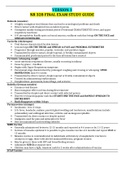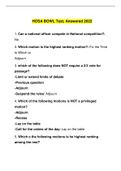-
1. Other - Nr 328 exam 2 study guide / nr328 exam 2 study guide: chamberlain college of nursing ...
-
2. Exam (elaborations) - Nr 328 final exam (162 qa) / nr328 final exam (162 qa): chamberlain college of nursin...
-
3. Other - Nr 328 final exam study guide 3 versions / nr328 final exam study guide 3 versions: c...
-
4. Other - Nr 328 pediatric exam 3 study guide 4 version / nr328 pediatric exam 3 study guide 4 ...
-
5. Exam (elaborations) - Nr 328 pediatric nursing exam 1 study guide / nr328 pediatric nursing exam 1 study gu...
-
6. Exam (elaborations) - Nr 328 pediatric nursing practice questions / nr328 pediatric test 1 practice questi...
-
7. Exam (elaborations) - Nr 328 pediatrics nursing final exam test bank 3
-
8. Other - Nr 328 pediatrics study guide 1 / nr328 pediatrics study guide 1: chamberlain college...
-
9. Other - Nr 328 pediatrics study guide 2 / nr328 pediatrics study guide 2: chamberlain college...
-
10. Exam (elaborations) - Nr 328 peds cardiac quiz / nr328 peds cardiac quiz: chamberlain college of nursing - ...
-
11. Exam (elaborations) - Nr 328 peds final exam 1/ nr328 peds ati final exam 1 test bank(latest) pediatric nur...
-
12. Exam (elaborations) - Nr 328 peds exam 1 study guide 6 versions / nr328 peds exam 1 study guide 6 versions:...
-
13. Other - Nr 328 peds exam 2 study guide 2 versions / nr328 peds exam 2 study guide 2 versions:...
-
14. Exam (elaborations) - Nr 328 peds final exam 1 nr328 peds ati final exam 1 test bank(latest) pediatric nur...
-
15. Exam (elaborations) - Nr 328 peds hospitalization quiz / nr328 peds hospitalization quiz: chamberlain colle...
-
16. Exam (elaborations) - Nr 328 peds pain assessment quiz / nr328 peds pain assessment quiz: chamberlain colle...
-
17. Exam (elaborations) - Nr 328 peds respiratory quiz / nr328 peds respiratory quiz: chamberlain college of nu...
-
18. Exam (elaborations) - Nr 328 peds test/ nr328 peds ati test (latest) pediatric nursing chamberlain (100 qa)
-
19. Other - Nr 302 exam 5 study guide / nr302 exam 5 study guide: chamberlain college of nursing ...
-
20. Other - Nr 302 exam 5 study guide / nr302 exam 5 study guide: chamberlain college of nursing ...
-
21. Other - Nr 302 exam 5 study guide / nr302 exam 5 study guide: chamberlain college of nursing ...
-
22. Other - Ati proctored pharmacology study guide: chamberlain college of nursing - latest, a co...
-
23. Other - Ati proctored pharmacology study guide: chamberlain college of nursing - latest, a co...
-
24. Other - Ati proctored pharmacology study guide: chamberlain college of nursing - latest, a co...
-
25. Case - Nr 302 ati woundcare / nr 302 ati woundcare: chamberlain college of nursing - latest,...
-
26. Case - Nr 302 ati woundcare / nr 302 ati woundcare: chamberlain college of nursing - latest,...
-
27. Exam (elaborations) - Nr 302 ati woundcare / nr302 ati woundcare: cahmberlain college of nursindocument for...
-
28. Exam (elaborations) - Nr 302 ears practice questions & answer / nr302 ears practice questions & answer: cah...
-
29. Exam (elaborations) - Nr 302 ears practice questions & answer / nr302 ears practice questions & answer: cah...
-
30. Exam (elaborations) - Nr 302 ears practice questions & answer / nr302 ears practice questions & answer: cah...
-
31. Other - Nr 302 exam 1 study guide/ nr302 test 1 study guide: cahmberlain college of nursing -...
-
32. Other - Nr 302 exam 1 study guide / nr302 test 1 study guide: cahmberlain college of nursing ...
-
33. Other - Nr 302 exam 2 study guide health assessment 4 versions / nr302 exam 2 study guide hea...
-
34. Other - Nr 302 exam 2 study guide health assessment / nr302 exam 2 study guide health assessm...
-
35. Other - Nr 302 exam 2 study guide health assessment 4 versions / nr302 exam 2 study guide hea...
-
36. Other - Nr 302 exam 2 study guide / nr302 exam 2 study guide: cahmberlain college of nursing ...
-
37. Other - Nr 302 exam 2 study guide / nr302 exam 2 study guide: cahmberlain college of nursing ...
-
38. Other - Nr 302 exam 2 study guide health assessment / nr302 exam 2 study guide health assessm...
-
39. Other - Nr 302 exam 2 study guide / nr302 exam 2 study guide: cahmberlain college of nursing ...
-
40. Exam (elaborations) - Nr 302 exam 3 health assessment heart and neck vessels complete solution: cahmberlain...
-
41. Other - Nr 302 exam 2 study guide / nr302 exam 2 study guide: cahmberlain college of nursing ...
-
42. Other - Nr 302 exam 2 study guide / nr302 exam 2 study guide: cahmberlain college of nursing ...
-
43. Other - Nr 302 exam 3 study guide 3 version / nr302 exam 3 study guide 3 version: cahmberlain...
-
44. Other - Nr 302 exam 2 study guide / nr302 exam 2 study guide: cahmberlain college of nursing ...
-
45. Other - Nr 302 exam 3 study guide / nr302 exam 3 study guide: cahmberlain college of nursing ...
-
46. Other - Nr 302 exam 3 study guide / nr302 exam 3 study guide: cahmberlain college of nursing ...
-
47. Exam (elaborations) - Nr 302 exam 3 health assessment heart and neck vessels complete solution: cahmberlain...
-
48. Other - Nr 302 exam 4 study guide / nr302 exam 4 study guide: cahmberlain college of nursing ...
-
49. Other - Nr 302 exam 3 study guide 3 version / nr302 exam 3 study guide 3 version: cahmberlain...
-
50. Other - Nr 302 exam 5 study guide / nr302 exam 5 study guide: cahmberlain college of nursing ...
-
51. Exam (elaborations) - Nr 302 final exam study guide health assessment i (3 versions): cahmberlain college o...
-
52. Other - Nr 302 exam 3 study guide / nr302 exam 3 study guide-latest
-
53. Other - Nr 302 final exam study guide health assessment i / nr302 final exam study guide heal...
-
54. Other - Nr 302 exam 3 study guide / nr302 exam 3 study guide:latest
-
55. Other - Nr 302 final exam study guide / nr302 final exam study guide:latest
-
56. Other - Nr 302 exam 4 study guide / nr302 exam 4 study guide:latest
-
57. Other - Nr 302 final exam study guide / nr302 final exam study guide:latest
-
58. Other - Nr 302 exam 5 study guide / nr302 exam 5 study guide:latest
-
59. Other - Nr 302 health assessment exam 2 study guide / nr302 health assessment exam 2 study gu...
-
60. Other - Nr 302 final exam study guide health assessment i 3 version / nr302 final exam study ...
-
61. Other - Nr 302 health assessment exam 2 study guide / nr302 health assessment exam 2 study gu...
-
62. Other - Nr 302 final exam study guide health assessment i / nr302 final exam study guide heal...
-
63. Exam (elaborations) - Nr 302 health assessment heart, lungs, thorax complte solutions / nr302 health assess...
-
64. Other - Nr 302 final exam study guide / nr302 final exam study guide:latest
-
65. Exam (elaborations) - Nr 302 hesi health assessment pre test (latest 2020) chamberlain college of nursing
-
66. Other - Nr 302 final exam study guide / nr302 final exam study guide:latest
-
67. Exam (elaborations) - Nr 302 nose, mouth, and throat practice questions & answer:latest
-
68. Other - Nr 302 health assessment exam 2 study guide:latest
-
69. Exam (elaborations) - Nr 302 practice question & answer head, face, neck, and regional lymphatics:latest
-
70. Other - Nr 302 health assessment exam 2 study guide / nr302 health assessment exam 2 study gu...
-
71. Exam (elaborations) - Nr 302 practice question & answers(respiratory) / nr302 practice question & answers(r...
-
72. Exam (elaborations) - Nr 302 health assessment heart, lungs, thorax complte solutions:latest
-
73. Exam (elaborations) - Nr 302 practice questions bank / nr302 test bank:latest
-
74. Exam (elaborations) - Nr 302 hesi health assessment pre test (latest 2020) chamberlain college of nursing
-
75. Exam (elaborations) - Nr 302 quiz 1 / nr302 quiz 1:latest
-
76. Exam (elaborations) - Nr 302 nose, mouth, and throat practice questions & answer:latest
-
77. Other - Nr 302 test 2 study guide / nr302 test 2 study guide:latest
-
78. Exam (elaborations) - Nr 302 practice question & answer head, face, neck, and regional lymphatics
-
79. Other - Nr 302 unit 3 study guide / nr302 unit 3 study guide:latest
-
80. Exam (elaborations) - Nr 302 practice question & answers(respiratory) / nr302 practice question & answers(r...
-
81. Other - Nr 302 physical assessment – exam 3 study guide / nr302 physical assessment – exa...
-
82. Exam (elaborations) - Nr 302 practice questions bank / nr302 test bank:latest
-
83. Exam (elaborations) - Nr302-health assessment i exam 2 / nr 302-health assessment i exam 2:latest
-
84. Exam (elaborations) - Nr 302 quiz 1 / nr302 quiz 1:latest
-
85. Other - Nr 302 test 2 study guide / nr302 test 2 study guide:latest
-
86. Other - Nr 302 unit 3 study guide / nr302 unit 3 study guide:latest
-
87. Other - Nr-302 physical assessment – exam 3 study guide / nr302 physical assessment – exa...
-
88. Exam (elaborations) - Nr302-health assessment i exam 2
-
Show more





